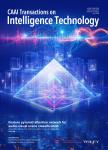版权所有:内蒙古大学图书馆 技术提供:维普资讯• 智图
内蒙古自治区呼和浩特市赛罕区大学西街235号 邮编: 010021

作者机构:School of Computing Informatics and Decision Systems Engineering Arizona State University Tempe AZ 85287-8809 USA School of Information Science and Engineering University of Jinan Shandong People's Republic of China
出 版 物:《CAAI Transactions on Intelligence Technology》 (智能技术学报(英文))
年 卷 期:2018年第3卷第2期
页 面:119-130页
核心收录:
学科分类:12[管理学] 1201[管理学-管理科学与工程(可授管理学、工学学位)] 081104[工学-模式识别与智能系统] 08[工学] 0835[工学-软件工程] 0811[工学-控制科学与工程] 0812[工学-计算机科学与技术(可授工学、理学学位)]
基 金:The authors wish to acknowledge those who contributed and helped in conceptualization and development of ASU VIPLE. Particularly Dr. Yann-Hang Lee co-advised some of the student teams working on the related projects. Garrett Drown developed the first version of the eRobotics visual programming tool. Garret Walliman implemented the second version of the visual programming language. Calvin Cheng helped in the early development of VIPLE and contributed the EV3 APIs for VIPLE. Tara De Vries contributed to the service integration of VIPLE development. Megan Plachecki and John Robertson contributed to the JSON interface design the implementation of the middleware on the Edison robot and the robot hardware design. Matthew De Rosa developed the first version of the VIPLE Unity simulator
摘 要:This study presents the authors' recent research and application of a new visual programming language and its development environment: VIPLE (Visual IoT/Robotics Programming Language Environment) at Arizona State University (ASU). ASU VIPLE supports a variety of loT devices and robots based on an open architecture. Based on computational thinking, VIPLE supports the integration of engineering design process, workflow, fundamental programming concepts, control flow, parallel computing, event-driven programming, and service-oriented computing seamlessly into a wide range of curricula, such as introduction to computing, introduction to engineering, service-oriented computing, and software integration. It is actively used at ASU in several sections of FSE 100: Introduction to Engineering and in CSE 446: Software Integration and Engineering, as well as in several other universities worldwide.